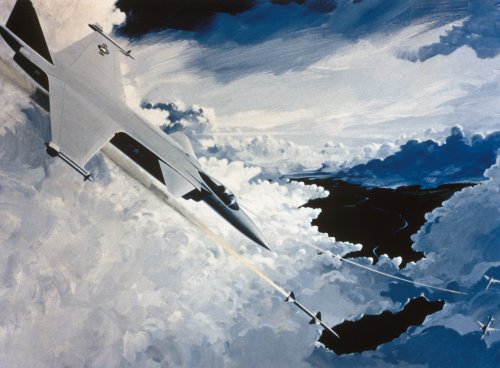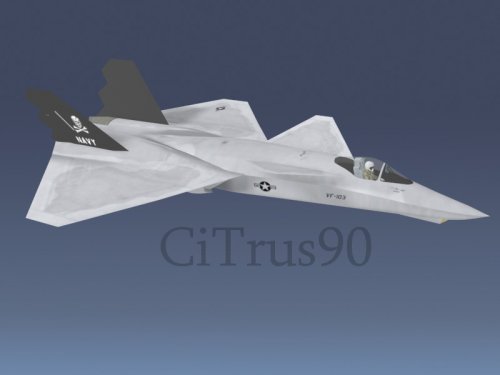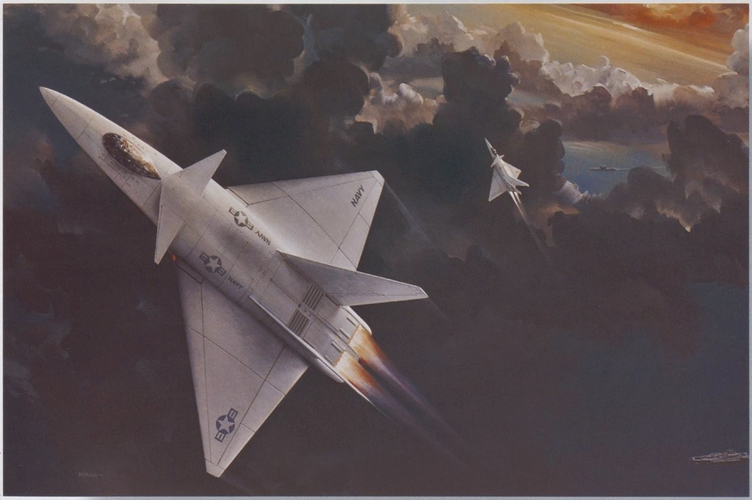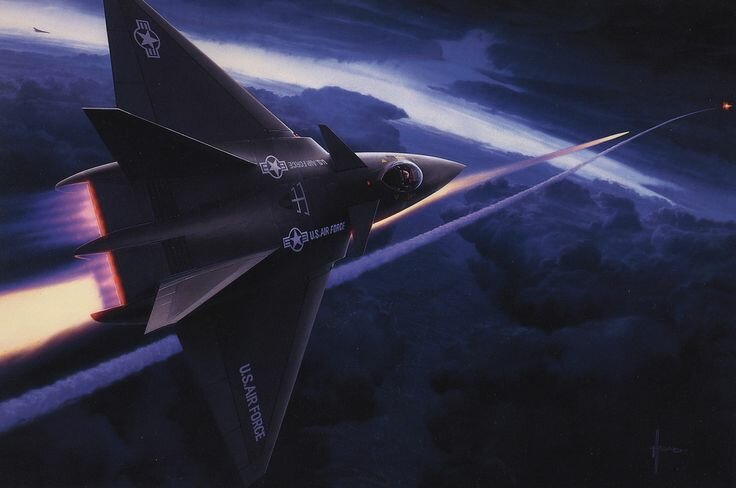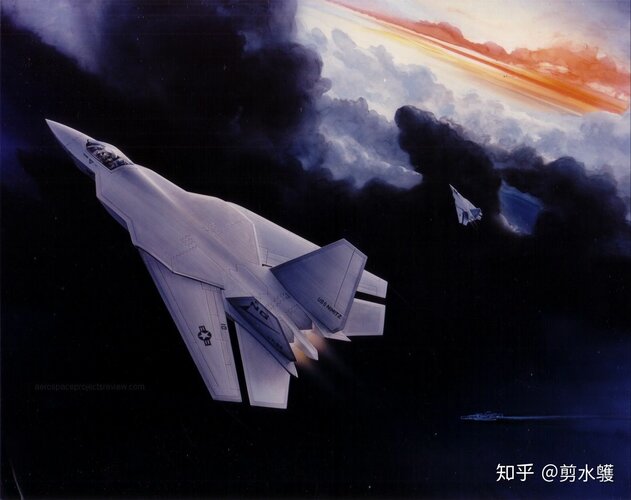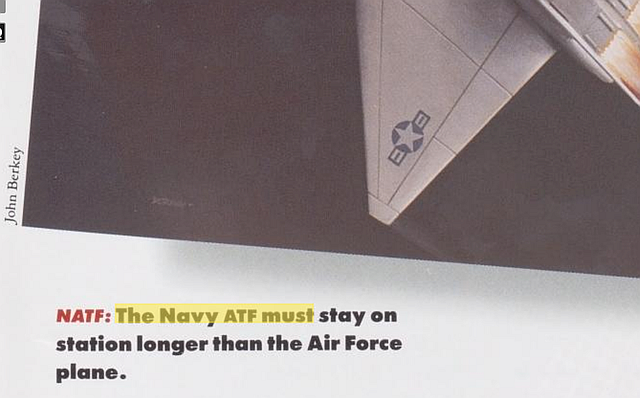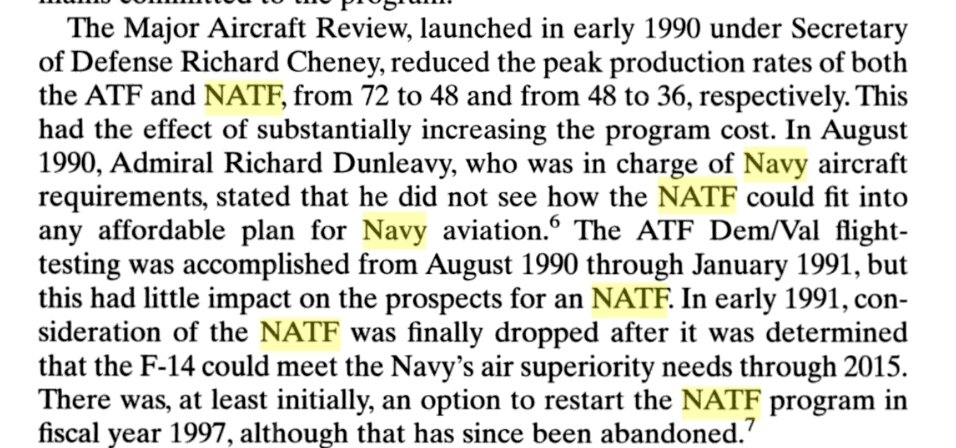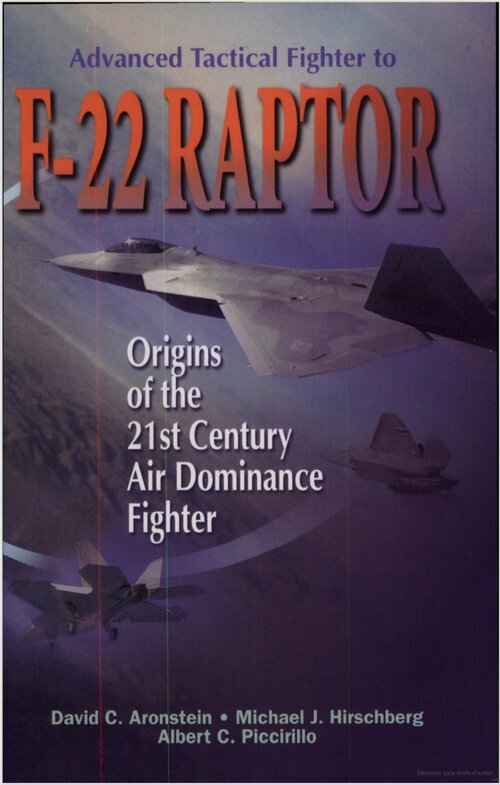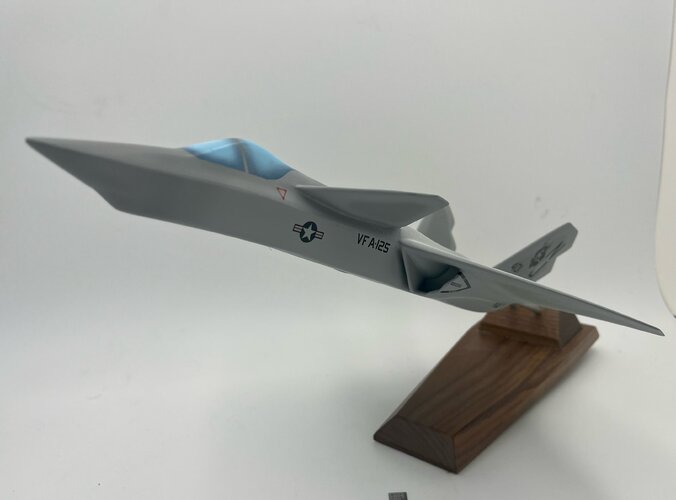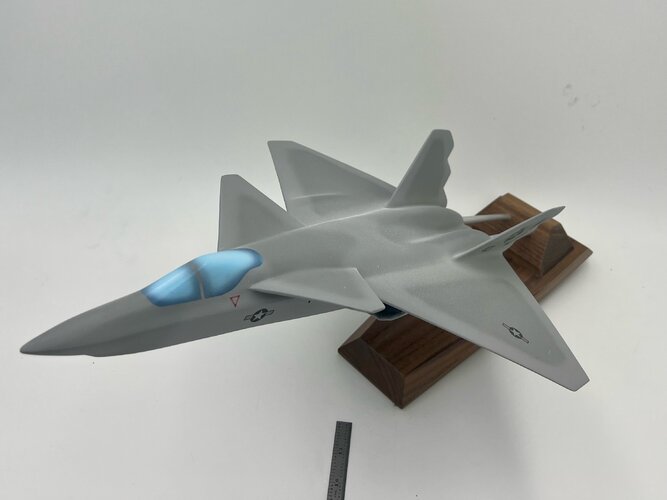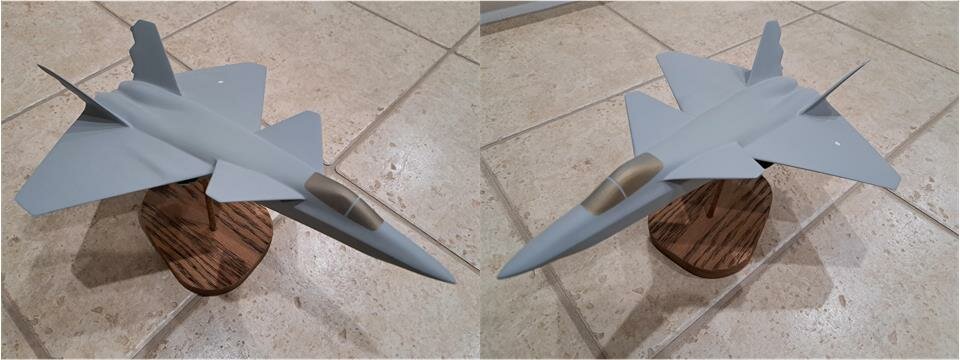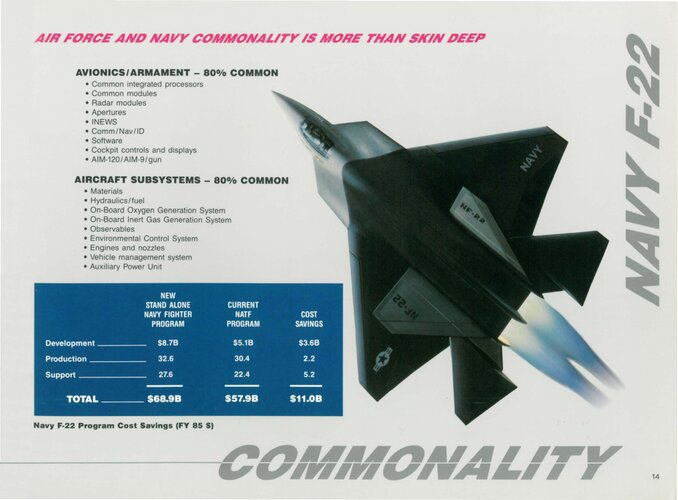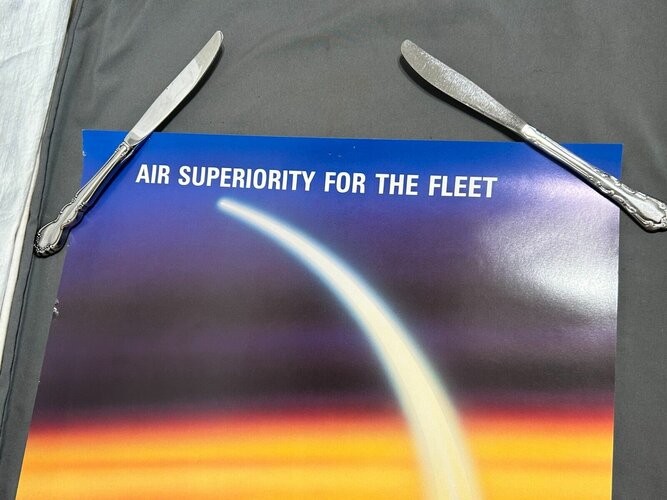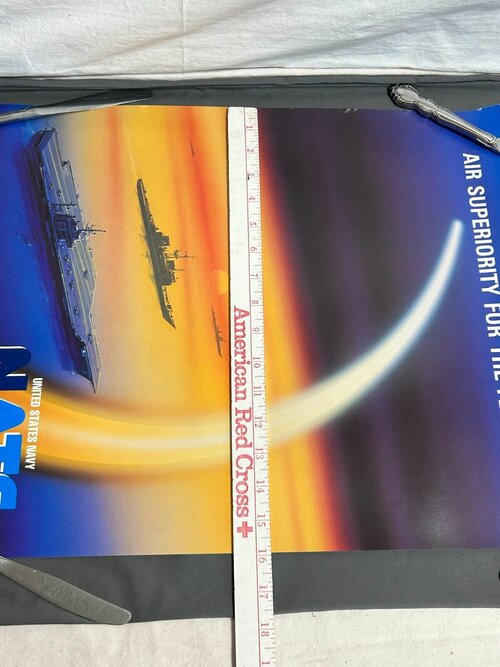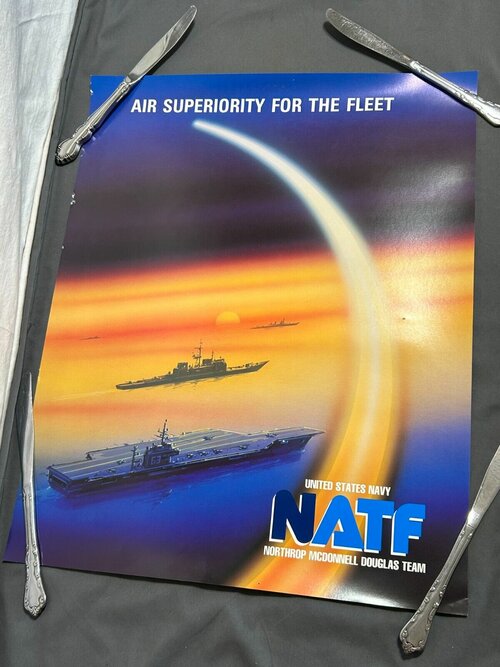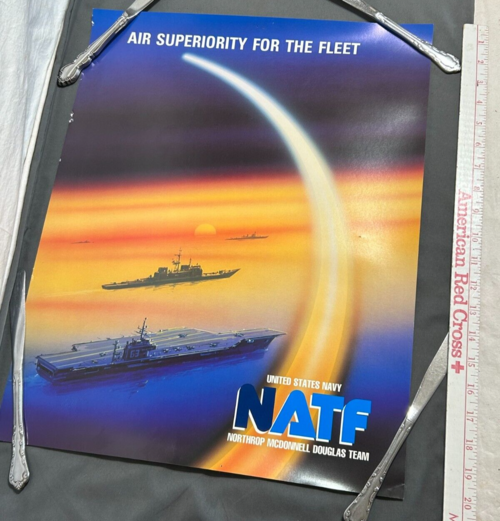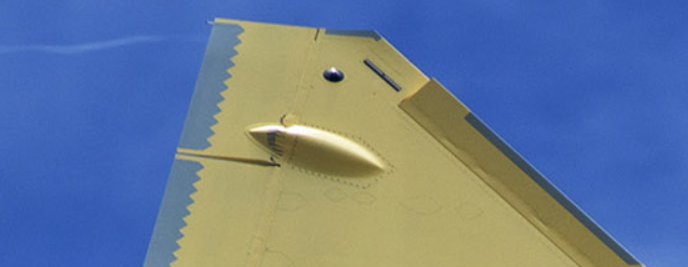You are using an out of date browser. It may not display this or other websites correctly.
You should upgrade or use an alternative browser.
You should upgrade or use an alternative browser.
NATF: planned Navy versions of the F-22 and F-23
- Thread starter Maki
- Start date
They made it a more realistic design, that concept's original wings make the Hornet's wings look stubby, and they got rid of the F-4 style intakes because it looks to me that this type of intake on a plane the scale of the NATF would have seen intake piping longer than 20 feet. Plus, they're both high wing,or at least shoulder wing, in contrast to the YF-23's mid-low wing.
That NATF model's accuracy is pretty middling, it has the YF-23's, for lack of a better term, intake lumps vs the more F-15 style siamese nacelles.
That NATF model's accuracy is pretty middling, it has the YF-23's, for lack of a better term, intake lumps vs the more F-15 style siamese nacelles.
- Joined
- 1 April 2006
- Messages
- 11,390
- Reaction score
- 10,276
You really should read Metz book on YF-23 to get the NATF-23 design evolution story from the first hands.Phos said:They made it a more realistic design, that concept's original wings make the Hornet's wings look stubby, and they got rid of the F-4 style intakes because it looks to me that this type of intake on a plane the scale of the NATF would have seen intake piping longer than 20 feet. Plus, they're both high wing,or at least shoulder wing, in contrast to the YF-23's mid-low wing.
- Joined
- 27 December 2005
- Messages
- 17,748
- Reaction score
- 26,407
What is the source of the picture?
Naming sources is a key forum principle.
Naming sources is a key forum principle.
- Joined
- 2 May 2007
- Messages
- 496
- Reaction score
- 1,958
The one I posted, or the two sferrin did? (or the two from flateric above that... or..) ?What is the source of the picture?
Naming sources is a key forum principle.
- Joined
- 27 December 2005
- Messages
- 17,748
- Reaction score
- 26,407
You, primarily, as you are quoting from the caption of an unknown publication. But yes, everyone should be doing it.The one I posted, or the two sferrin did? (or the two from flateric above that... or..) ?What is the source of the picture?
Naming sources is a key forum principle.
Your "Navy ATF" picture predates the unveiling of the ATF designs, and is not a real design.
Last edited:
- Joined
- 24 November 2008
- Messages
- 1,549
- Reaction score
- 2,612
Abe G - IIRC the v-tails on the YF-23 were used entirely for pitch and roll. Yaw inputs came from differential movement of the wing TE surfaces.
Now that's interesting. I think it is common practice nowadays that all control surfaces of a fighter work in concert to establish the desired movement. Was yaw really entirely controlled by the TE surfaces?
- Joined
- 24 November 2008
- Messages
- 1,549
- Reaction score
- 2,612
Abe G - IIRC the v-tails on the YF-23 were used entirely for pitch and roll. Yaw inputs came from differential movement of the wing TE surfaces.
Now that's interesting. I think it is common practice nowadays that all control surfaces of a fighter work in concert to establish the desired movement. Was yaw really entirely controlled by the TE surfaces?
In this video former NG test pilot Roy Martin explains how the control system works... The above statement is not confirmed.
apparition13
I really should change my personal text
- Joined
- 27 January 2017
- Messages
- 604
- Reaction score
- 1,107
Quick question, one of the reasons given for the NATF cancellation was a reduction in the production rate of the ATF/NATF to a point the Navy thought unit prices would be unaffordable. Does anyone know what the original production rate per year was supposed to be, and what it dropped to that may have caused the Navy to drop out?
Manuducati
ACCESS: Secret
- Joined
- 25 November 2020
- Messages
- 332
- Reaction score
- 1,065
- Joined
- 22 October 2006
- Messages
- 338
- Reaction score
- 76
A 3d model of the natf-23 is available At turbo squid
It is of good quality, and allows you to confirm that the canards make the rear hemisphere visibility non existent. I don't see how such a design would have been accepted by the navy. Thus, I wonder if the wind tunnel model was tested with or without canards.
It is of good quality, and allows you to confirm that the canards make the rear hemisphere visibility non existent. I don't see how such a design would have been accepted by the navy. Thus, I wonder if the wind tunnel model was tested with or without canards.
- Joined
- 1 April 2006
- Messages
- 11,390
- Reaction score
- 10,276
Lockheed's NATF larger and heavier than YF-22. (Navy Advanced Tactical Fighter)
Source: Defense Daily
Publication Date: 30-JAN-91
The Lockheed/Boeing/General Dynamics Navy Advanced Tactical Fighter NATF) will have essentially
the same guts as the Air Force ATF, but, because the NATF will be carrier based and required to
carry more fuel, it will be a larger aircraft and have a heavier airframe than the Air Force derivative,
Lockbeed Vice President and ATF General Manager James "Mickey" Blackwell said yesterday.
The NATF will carry virtually all the avionics that will be used in the ATF, but will also have avionics
particular to carrier-based aircraft, Blackwell said. The NATF airframe will be considerably different
than the ATF because it will be required to land on carriers. The catapult and stopping mechanism
on an aircraft carrier places tremendous strain on an airframe, Blackwell said, which requires a
more sturdy airframe than land-based aircraft.
As in the F-14 Tomcat, the Lockheed NATF will have swing wings, which, when set in a forward
swept direction, will provide the aircraft greater lift needed for carrier launches.
The main criteria for that Navy airplane is carrier suitability, which translates into high lift, Blackwell
said. "You have to maximize the high lift of a Navy airplane in order to get on and off a Navy
carrier. That will require a different wing on the airplane rather than what we have on the ATF. But
when you look at the two airplanes from a distance they will be brother and sisters. Swing wings
let us optimize several flight regimes. Rather than going out to supercruise, air-superiority
missions for the F-15, it does that and does it well, but it also does the combat air patrol mission.
It has longer legs and it will endure longer."
The NATF will also be required to fill a limited attack role, while the ATF is purely an air-superiority
aircraft. However, Lockheed's ATF could be further modified to include an attack role.
Low Observable Capability Diminished Due To Size Of NATF
With the added size of the airframe, the low-observable signature of Lockheed's NATF will
increase. However, Blackwell said trade-offs were expected, "the airframe will be tailored to the
Navy mission." About 25 percent of the NATF airframe will be common with Lockheed's ATF. "The
Navy airplane uses 100 percent of the ATF avionics," Blackwell said. "We marinized the engines so
they will be used by both aircraft. Virtually all the subsystems will be common." Lockheed is also
studying a two seat aircraft for the Navy contract, Black-well said.
At the low and high ends of speed extremes the YF-22 ATF's thrust vectoring will provide the
aircraft with the ability to maneuver with greater efficiency than its predecessors, Blackwell said.
Thrust vectoring is the ability to guide the thrust of the engines in an up or down direction to
further enhance maneuverability of the aircraft. At very high speeds the aircraft's controlling
surfaces are limited in their ability to influence movement through the air, Test Pilot Dave Ferguson
said. Thrust vectoring provides greater control to the pilot. It is also important because it allows
for greater maneuverability at extreme high angles of attack. With vectoring controlling the
direction of the aircraft, controlling surfaces are free to manage roll and other maneuver
capabilities, Ferguson said. The YF-22 reached a 60 degree angle of attack in prototype testing
and displayed an ability to role 100 degrees at that angle of attack.
The Lockheed team's competitor, the Northrop/McDonnell Douglas YF-23, does not utilize thrust
vectoring.
Achieved Every Goal
Blackwell said Lockheed approached the ATF program with eight specific goals, which included:
building a stealthy plane; achieving supercruise; extreme maneuverability; lethality; advanced,
affordable avionics; built in growth for the aircraft; a supportable aircraft; and overall affordable.
He said the Lockheed team had achieved all its goals.
There will be minor changes in the airframe from the prototype aircraft to the production aircraft,
according to Blackwell. He said the canopy of the aircraft will be moved slightly forward, while the
landing gear doors will be more parallel to the wind. There will, however, be "massive changes"
internally. Blackwell said there will be a great use of composites. He said that all internal loads
were theoretical in the prototype stage and that attempts will be made at every opportunity to
decrease the weight of the aircraft.
To date approximately $1.9 billion has been invested in the ATF demonstration/validation program
by the Air Force, Lockheed/Boeing/General Dynamics and their subcontractors. The Air Force
provided $818 million, Lockheed/Boeing/General Dynamics split equally $675 million and
subcontractors invested $408 million. The Navy has provided $65 million for the NATF to date.
Last edited by a moderator:
Dreamfighter
'Senior Something'
- Joined
- 13 July 2008
- Messages
- 483
- Reaction score
- 646
Lockheed's NATF larger and heavier than YF-22. (Navy Advanced Tactical Fighter)
Source: Defense Daily
Publication Date: 30-JAN-91
...
Thanks for posting. Nice to be able to read the whole article again after so many years.
- Joined
- 1 April 2006
- Messages
- 11,390
- Reaction score
- 10,276
Lockheed says NATF meets nearly all AX requirements.
Source: Defense Daily
Publication Date: 09-SEP-91
(Las Vegas) The Lockheed-Boeing-General Dynamics team's naval version of the Advanced Tactical
Fighter (NATF) currently meets 95 percent of the Navy's requirements for the future AX bomber,
Lockheed officials said last week.
"The NATF was developed with significant air-to-ground capability, and while I can't go into
numbers, I'd have to say it was significant and in fact, the way the NATF sits today it can meet 95
percent of the AX specification requirements," one Lockheed official said during the 34th annual
TailHook Association Convention last week. A request for proposals (RFP) was released to
contractors by the Navy during a classified briefing over a week ago outlining requirements for the
AX (Defense Daily, August 29). The service plans to procure 234 AX aircraft to enter the carrier
airwing fleet by 2010, according to the RFP.
The Lockheed official said that, "there were a lot of compromises in the YF-22 prototype design to
accommodate a Navy airplane, but we worked very, very hard on that."
"We have a Navy version that has a swing ring that was never built ... that is carrier-suitable and
also has a capability to get into the higher speed mode of the outer air stealth ... for the
strike/fighter design," the official said. He added that while the NATF was designed with both
strike and fighter capabilities in mind, "we feel very strongly that if the Navy chooses to go the
strike/fighter route in the AX, the type of airplane we would build on paper, or NATF, would be
competitive."
Lockheed officials also said that the aircraft can meet the service requirement of carrying weapons
both internally and externally. The Navy "could hang a bunch of bombs on it and still maintain the
stealth ... but we have an internal stealthy capability and then an external capability that can get
you a significant total amount of weapons," one company official said.
The Navy canceled its participation in the Air Force-led effort to develop an advanced tactical
fighter last year. In late April, the Air Force selected the team of Lockheed-General Dynamics-
Boeing to develop its YF-22 ATF prototype aircraft. The Lockheed team intends to offer a version of
the YF-22 as the basis of its bid on the AX.
A total of five industry teams or individual firms will be selected to enter AX Concept Exploration
Definition studies, which are estimated to be worth $20 million a piece. In addition to the
Lockheed proposal, three teams have announced they will compete for the development of the AX.
Lockheed will offer a new design with teammates Boeing and Grumman. General Dynamics and
McDonnell Douglas will submit a version of the now-defunct A-12. McDonnell Douglas and LTV will
team to offer a new design.
Last edited by a moderator:
Scott Kenny
ACCESS: USAP
- Joined
- 15 May 2023
- Messages
- 11,628
- Reaction score
- 14,305
That looks substantially longer than the F22, a good 5-6 feet or so.
- Joined
- 11 March 2011
- Messages
- 307
- Reaction score
- 1,194
- Joined
- 28 January 2008
- Messages
- 1,016
- Reaction score
- 2,205
I have the same model, given to me when I was at Northrop, it was a blank as well and I finished it. I will take a photo and post it.Came to me as a blank... 1:40th Northrop NATF-23. 2nd one I have had. Still trying to decide if I want to put the panel lines/flying surfaces on it. Getting lazy in my old age.
- Joined
- 11 March 2011
- Messages
- 307
- Reaction score
- 1,194
Look forward to seeing it.. Did you work for Tony or Dick?I have the same model, given to me when I was at Northrop, it was a blank as well and I finished it. I will take a photo and post it.
- Joined
- 28 January 2008
- Messages
- 1,016
- Reaction score
- 2,205
I worked at Pico Rivera then at the B-2 CTF. I used to support YF-23 when needed.Look forward to seeing it.. Did you work for Tony or Dick?
- Joined
- 28 January 2008
- Messages
- 1,016
- Reaction score
- 2,205
Here is my NATF-23 model, not as nice as yours, my raw casting blank was kind of rough.Came to me as a blank... 1:40th Northrop NATF-23. 2nd one I have had. Still trying to decide if I want to put the panel lines/flying surfaces on it. Getting lazy in my old age.
Attachments
- Joined
- 11 March 2011
- Messages
- 307
- Reaction score
- 1,194
Looks great! Mine was the yellow stinky resin as I am sure was yours. A lot of filling and priming to be sure. I started with a splinter camo and was almost done.... and decided on the layout you see, so a bit of sanding and Taaa Daaaaaa!
- Joined
- 28 January 2008
- Messages
- 1,016
- Reaction score
- 2,205
Mine was the same yellow resin as well, I thought my buddy in the model shop maybe had mine made from cheese.Looks great! Mine was the yellow stinky resin as I am sure was yours. A lot of filling and priming to be sure. I started with a splinter camo and was almost done.... and decided on the layout you see, so a bit of sanding and Taaa Daaaaaa!
- Joined
- 11 March 2011
- Messages
- 307
- Reaction score
- 1,194
LOL.. yeah. The old resin supplier FINALLY changed the formula so it did not smell like stinky foot......and made it white as well.Mine was the same yellow resin as well, I thought my buddy in the model shop maybe had mine made from cheese.
ScrutorAudax
ACCESS: Confidential
- Joined
- 4 June 2015
- Messages
- 66
- Reaction score
- 99
- Joined
- 1 April 2006
- Messages
- 11,390
- Reaction score
- 10,276

16 x 20 vintage US Navy NATF Northrup McDonnell Douglas Team EARLY F-22 Poster | eBay
There are small pin holes on the top/bottom from being on a wall. Many photos are TYPE 1 ORIGINALS from the archives of McDonnell Douglas.
www.ebay.com
Attachments
Colonial-Marine
UAVs are now friend, drones are the real enemy.
- Joined
- 5 October 2009
- Messages
- 1,470
- Reaction score
- 1,323
For some reason it only recently came to my attention that Northrop's NATF-23 incorporated 2D thrust vectoring unlike the F-23 itself. I find that a bit surprising given what I would have assumed the Navy's requirements were. It seems unlikely the Navy's performance requirements for agility would be even higher than the Air Force's so perhaps there was some perceived loss of performance with the NATF's revised wing and tail layout versus that of the USAF's F-23? It looks like the DP-533 NATF design with the conventional tail might have also featured thrust vectoring. Or maybe the Navy was less focused on low-observability than the USAF, so adding thrust vectoring really wouldn't do any harm.
In some alternate reality where Northrop had won the ATF contract and then the NATF program actually goes ahead I wonder if the serrated vertical tail would have made it to the prototype and then production aircraft? It seems no other LO fighter designs in the years following the ATF and NATF programs have adopted a similar feature even though on paper it would help reduce RCS. I'd have to assume there is some reason for that, a design option that must be a dead-end for some reason or another.
In some alternate reality where Northrop had won the ATF contract and then the NATF program actually goes ahead I wonder if the serrated vertical tail would have made it to the prototype and then production aircraft? It seems no other LO fighter designs in the years following the ATF and NATF programs have adopted a similar feature even though on paper it would help reduce RCS. I'd have to assume there is some reason for that, a design option that must be a dead-end for some reason or another.
Last edited:
- Joined
- 15 January 2021
- Messages
- 396
- Reaction score
- 1,455
While the YF-23/YF119 did not have overt thrust vectoring like the YF-22, there was limited thrust vectoring available by moving the upper divergent flap off of the optimum expansion ratio position. Over-expanding gave a slight nose up vector, while under-expanding gave a slight nose down vector. Don’t know if this is what was planned for the NATF F-23, or they were going to the full vectoring dual independent divergent segments.
- Joined
- 1 April 2006
- Messages
- 11,390
- Reaction score
- 10,276
Reason is well known and this is carrier elevator size limits. Some of paper carrier based aircrafts projects afair had the same feature, not talking of LO cruise missiles (i.e. Boeing JASSM contender) etc. Size/volume limits with a need to keep control surface area of required size is a driving factor.It seems no other LO fighter designs in the years following the ATF and NATF programs have adopted a similar feature even though on paper it would help reduce RCS. I'd have to assume there is some reason for that, a design option that must be a dead-end for some reason or another.
donnage99
ACCESS: Top Secret
- Joined
- 16 June 2008
- Messages
- 1,355
- Reaction score
- 868
This is how you solve the problem with having the rear leading edges not aligned with the front without having sawtooth wings or tails. This is J-20 but given how its stealth is lifted right out of breaking into lockheed's database I wouldn't doubt this is how f-22 or f-35 solves the problem with their wings and tails' rear leading edges as well. The drawback is probably added weight vs a pure sawtooth trailing edge like northrop natf or General Dynamics ATF submission.For some reason it only recently came to my attention that Northrop's NATF-23 incorporated 2D thrust vectoring unlike the F-23 itself. I find that a bit surprising given what I would have assumed the Navy's requirements were. It seems unlikely the Navy's performance requirements for agility would be even higher than the Air Force's so perhaps there was some perceived loss of performance with the NATF's revised wing and tail layout versus that of the USAF's F-23? It looks like the DP-533 NATF design with the conventional tail might have also featured thrust vectoring. Or maybe the Navy was less focused on low-observability than the USAF, so adding thrust vectoring really wouldn't do any harm.
In some alternate reality where Northrop had won the ATF contract and then the NATF program actually goes ahead I wonder if the serrated vertical tail would have made it to the prototype and then production aircraft? It seems no other LO fighter designs in the years following the ATF and NATF programs have adopted a similar feature even though on paper it would help reduce RCS. I'd have to assume there is some reason for that, a design option that must be a dead-end for some reason or another.
As for thrust vectoring, it probably helps with slow speed handling trying to land on a carrier with high wing sweep. It will probably also help with not having to use control surfaces as much, notably the canards, helping stealth.
Attachments
Similar threads
-
-
FLIGHTS OF FANTASY: The Boeing/Lockheed A/FX
- Started by Sentinel Chicken
- Replies: 52
-
-
-
Advanced Tactical Support Aircraft (ATSA) US Navy
- Started by dauby09
- Replies: 22

